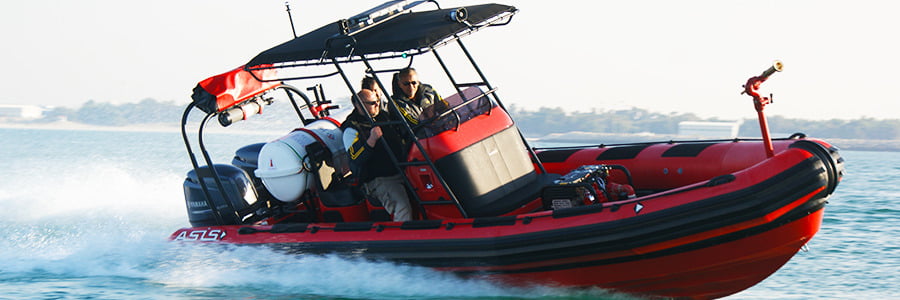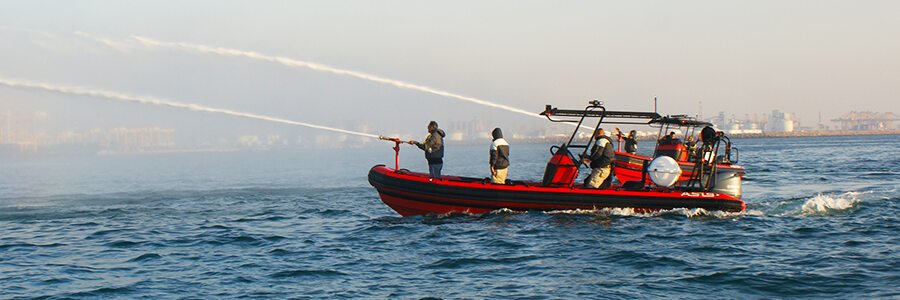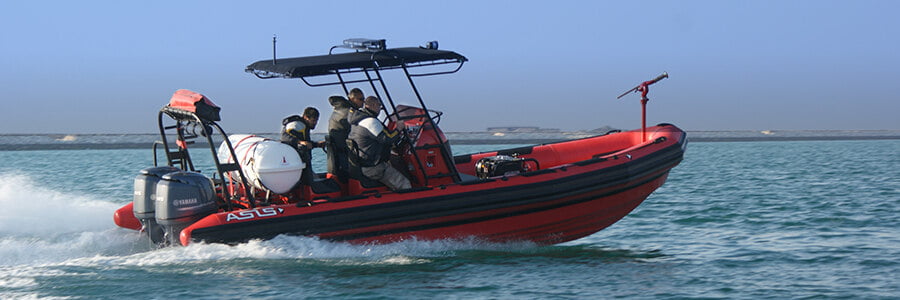Everything your need to know about fire boats
WHAT ARE FIRE BOATS:
Fire Boats are ships made to fight and extinguish fires both from the water or on water. They have a variety of applications such as the protection of ports, coastal areas, and riverine communities. In this article, we will explore the history of fire boats, their evolution, and technological advancements as well as the different types of fires and the types of fire boats that are used to fight them. We will also discuss the various use cases and responsibilities of fireboats in the protection of ports and coastal communities, as well as their key features, the importance of regular maintenance, and what to consider when purchasing a fire boat.
At ASIS, our Fire Boats are made to order and purpose-built to carry out firefighting and search and rescue missions in the toughest conditions. They come equipped with a self-righting system and can be outfitted with various combinations of accessories such as a High-Pressure pump, a life raft, dive bottle racks, rescue baskets, and parbuckling rescue nets.
BRIEF HISTORY:
The first fire boats were used in the late 18th century, small in size, they were rowed to the site by the crew and a manual water pump was used. Records show that London, UK was the first city to use fire boats, although some sources mention the use of fire boats in the early 19th century in New York, US, and later in Boston, US. These initial small boats paved the way to the development of the modern-day ones, through time, the ores were replaced by steam engines, and they were used in ports to fight fires that would set ablaze the boats in the wharves.

ROLE OF FIRE BOATS:
Fire boats can play different roles, some more important than others. They encompass firefighting, search and rescue missions, emergency medical assistance, and transport. Protecting the environment from pollution in case of oil Spillages in the ocean.
Fire extinguishing
Extinguishing fires is the primary role of a fire boat, therefore, all fire boats are equipped with Fire Fighting pumps to propel the water from a distance without endangering the lives of the ones aboard. The use of water as opposed to other extinguishing agents is preferred as a boat has a virtually unlimited supply of water available, however, depending on the type of fire, other extinguishing agents might be required.
Search and rescue operations
Search and rescue missions are also another important role that fire boats can play. They can be used to save lives during maritime catastrophes, and accidents in areas only reachable by sea or river, and can be used during floods to reach populated areas when ambulances cannot pass through. As such, Fire boats are often equipped with powerful communication systems and strong lighting projectors to be able to locate stranded people. Some fire departments also equip their fireboats with diving equipment in case they need to perform underwater missions.
Emergency medical services
Firefighters in general and the crews of fireboats are trained and equipped to be able to perform emergency medical procedures on the boat before reaching an ambulance or a hospital, especially at sea or in remote areas only accessible by water.
Pollution Control
From time to time, oil spillages happen either from oil rigs or from tanker ships, fireboats are then tasked to secure the perimeter of the spillage, put in place naval barriers to stop the spillage from spreading over a larger area, and start cleaning or eliminating the pollutants and residue they leave behind.

DIFFERENT USE CASES:
Fireboats are used to fight different types of fires, from fires in the offshore oil and gas platforms at sea to fires in ships and vessels, as well as fires in corners of the port that is easier accessed by water.
KEY FEATURES OF A FIRE BOAT:
Propulsion systems
Fireboats can be equipped with different propulsion systems, Diesel Engines, Gas Turbines, Water Jets engines, and outboard engines can all be found on different fireboats. Each of these systems has its advantages when it comes to speed, maneuverability, and operating range for a faster response to emergencies.
Water pumping and distribution systems found on fireboats
The pumping and distribution of the water on firefighting boats are designed to project water from a distance, therefore, fire boats are equipped with high-pressure pumps for a fast and efficient extinguishing process
Firefighting equipment carried by fireboats
The list of equipment carried by fire boats varies widely from one application to another, however, most of them will have a water cannon or turret, and a high-pressure pumping system to pump directly from the water underneath the boat. Water cannons are rotating devices that allow for a more precise response from the operator and are an efficient way to aim at a specific area. Some fire boats are also equipped with a defense system to protect the boat itself from fire.
Fire Fighting agents
A firefighting agent is either water or a chemical that helps extinguish fires. While water is the most common one due to its abundance around and underneath the boat, chemicals in the form of powder or foam, similar to the ones found in the extinguishers that you can find in a car or a building, can be used as well, especially when trying to extinguish an electrical fire or a fire caused by oil.
Safety equipment and systems found on fireboats
They are equipped with a multitude of safety equipment to protect the crew and passengers in case of an emergency, these equipment include liferafts, life vests, life rings, fireproof suits, and oxygen tanks. Communication systems are also very important and allow the crew to remain in contact with the port authority, the crew of the ship on fire, or the emergency services in charge of the operations.
BEFORE PURCHASING A FIRE BOAT:
Factors to consider when selecting a fire boat
When looking for a fire boat, some multiple factors and variables should be kept in mind to ensure that the fireboat will perform efficiently in the required environment. These factors are the following:
Size:
The dimensions and overall size of a fire boat will determine how agile and maneuverable it can be and will also impact the extent to which it can reach remote areas and tight passageways.
Power and gas consumption:
The power and gas consumption of the fire boat will affect the speed, operational range, and cost of usage of the boat.
Operational Capacity
The overall speed, crew and passenger capacity, water pumping power, and the number of water cannons are all important aspects to keep in mind when deciding on which fire boat is required. These factors will impact the overall ability of a boat to efficiently extinguish the fire.
It is also important to consider the specifications and legal requirements related to safety and to ensure that the boat adheres to the norms and standards for each application.
THE ADVANTAGES OF RIGID INFLATABLE BOATS IN FIREFIGHTING:
Rigid Inflatable Boats (RHIBs) offer several advantages over traditional Fire Boats. One of the most significant benefits is their combination of speed and maneuverability. Being lightweight and portable, RHIBs are easy to transport and deploy during emergencies, and they are capable of navigating shallow waters and tight spaces, allowing the crew to reach hard-to-reach areas and perform their duties efficiently. Another key aspect of RHIBs is the added buoyancy and stability provided by inflatable tubes, making them a safer option in rough water conditions.
At ASIS, our Firefighting RHIBs are made to order and purpose-built to carry out firefighting and search and rescue missions in the toughest conditions. They come equipped with a self-righting system and can be outfitted with various combinations of accessories such as a High-Pressure pump, a life raft, dive bottle racks, rescue baskets, and parbuckling rescue nets.

THE IMPORTANCE OF MAINTENANCE OF FIRE BOATS:
As is the case with any equipment, regular maintenance is a very important thing to ensure proper functioning. The maintenance should be done at regular intervals and after each firefighting or rescue mission following the recommendations of the manufacturer of each piece of equipment on the boat. The engine, the water pumps, the hoses, and the electric equipment should all be maintained properly. It is also important to regularly inspect the safety equipment such as the life vests and rafts.
CONCLUSION:
Fireboats are ships that are designed to protect communities, coastal properties, ports, ships, and offshore oil and gas platforms during maritime emergencies. They have evolved through time thanks to technological advancements and became more and more adaptable to a variety of use cases. Fire boats can also be used in rescue missions and can transport passengers back to safety.
Purchasing a fire boat requires a good amount of reflection and planning to ensure that the boat meets the specific needs of the end user, and we at ASIS Boats do just that, if you’re looking for a fire rescue boat, look no further and contact us right away. We manufacture purpose-built firefighting RIB tailored to your exact needs.


